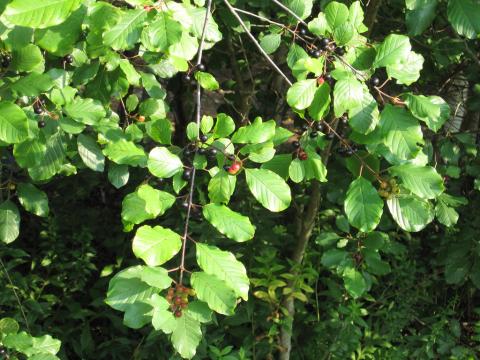Invasive in the Spotlight: Glossy Buckthorn

Glossy buckthorn (Frangula alnus) is native to Eurasia. When it was initially introduced it was used as a hedge and to create wildlife habitat. It is classified as an invasive species in New Hampshire because it creates dense thickets and outcompetes native plants. Glossy buckthorn leafs out earlier than most woody deciduous plants, and it drops its leaves later in the fall, providing a longer growing season and increased growth. It can invade a wide variety of habitats, from wetlands to white pine forests or woodland edges, preferring areas with plenty of light and disturbed soil. It produces large amounts of fruit which are consumed by birds and small mammals, who in turn spread the seeds to new areas.
Description
Glossy buckthorn is a tall, deciduous shrub that grows up to 20 feet tall and 15 feet wide. The bark is grayish to brown with slightly raised white bumps called lenticels. The leaves are dark green on top and dull green on the bottom, four to five inches long and three to four inches wide, with smooth, slightly wavy edges. The leaf veins are very clearly defined and have a distinctive “fishbone” appearance. The leaves may be arranged in a whorled or alternate pattern on the cinnamon colored stems. In the fall, the leaves turn pale yellow.
In mid-May to mid-June, small, greenish-yellow, inconspicuous, four-petaled flowers appear. After pollination, fruit forms in mid to late summer, and is about ¼ inch in diameter. It ripens from red to dark purple or black in the fall. The fruit, as well as the bark and roots, produce anthroquinone, an organic compound that metabolizes into the laxative emodin when digested. If eaten in large quantities, glossy buckthorn fruit can cause nutritional deficiencies in wildlife.
Control
A primary goal in controlling glossy buckthorn is to prevent the seed production and distribution. Glossy buckthorn is best controlled with an Integrated Pest Management (IPM) for Woody Plants, which means combining mechanical and chemical control methods. Young plants can be pulled by hand or dug up, and mowing will prevent seedlings from establishing. Cutting down mature glossy buckthorn without removing the root system will not eliminate it, but rather encourage extensive root sprouts to develop, making the plant even harder to control.
If dealing with mature plants, chemical control may be necessary. Cutting stems and treating them with an herbicide with the active ingredients glyphosate or triclopyr can limit resprouting. Make sure to read and follow the product label instructions for cut stump application. Apply herbicides carefully to avoid harming non-target plants.
Prevailing Wisdom
While the prevailing wisdom is that researchers don't have much useful information about glossy buckthorn, Dr. Tom Lee, associate professor of forest ecology in the Dept. of Natural Resources and the Environment at the University of New Hampshire and researcher at NH Agricultural Experiment Station, disagrees.
These two articles speak to UNH research and observations on glossy buckthorn:
What We Know About Glossy Buckthorn by UNH Extension Forestry Information Specialist Karren Bennett
UNH Researchers Aim to Get Upper Hand in Glossy Buckthorn Battle by the New Hampshire Agricultural Research Station
UNH Cooperative Extension Master Gardener volunteers share information about home, yard, and garden topics with the people of New Hampshire. Got questions? Master Gardeners provide practical help finding answers to your questions through the Ask UNH Extension Infoline. Call toll free at 1-877-398-4769, Monday to Friday, 9 a.m. to 2 p.m., or e-mail us at answers@unh.edu.
Related Resource(s)
Do you love learning about stuff like this?
SUBSCRIBE TO Granite State Gardening newsletter
Got questions? The UNH Extension Yard and Garden Infoline offers practical help finding answers for your yard and garden questions.
Call toll free at 1-877-398-4769, Monday to Friday, 9 a.m. to 2 p.m., or fill out webform.

